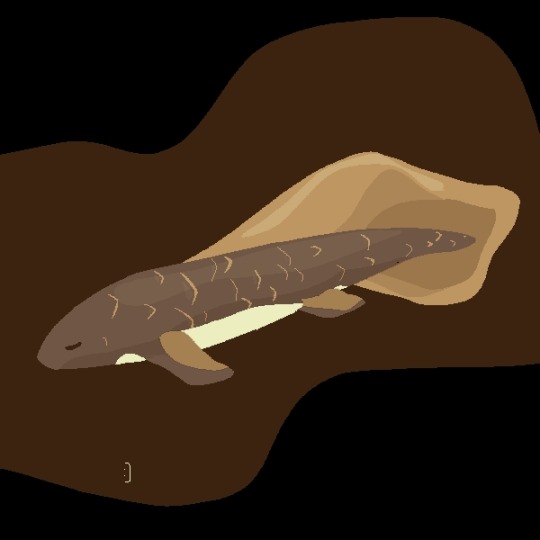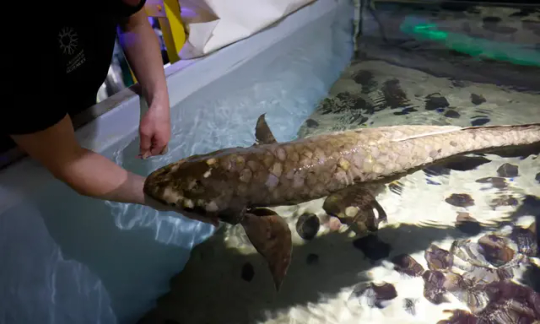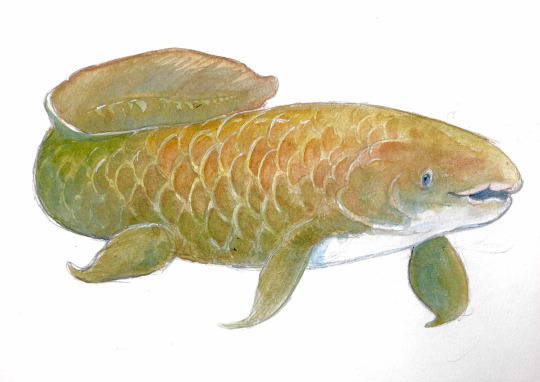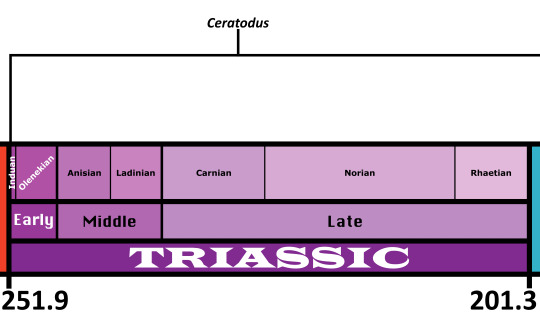#queensland lungfish
Text
now for a day ive been waiting for; day 28, with a little queensland lungfish :D
i love these guys *so much* and they deserve the world!

#fishuary2024#fish#pixel art#lungfish#queensland lungfish#oh how i love them so#i have been calling this little guy 'coffee' in my head while drawing this#i think i just feel like a latte lmao
7 notes
·
View notes
Photo

Inktober day 11: Australian lungfish
20 notes
·
View notes
Text
will quickly say that. i deifnitely see why everyone loves coelacanths and why they're the most popular/well known of the lobefins (excluding us tetrapods), not just because they are fascinating creatures but because of the story of their discovery, but i can't help but feel like they overshadow their lungfish cousins a little. lungfish need more LOVE!!!!!
they're the closest relative of us tetrapods that're still extant today, closer to us than coelacanths, they LITERALLY have lungs hence the name and i'm pretty sure one or two species of lungfish are obligate airbreathers--meaning these are fish species that can drown. queensland lungfish in particular fascinate me, cause they have the most developed fins, and it REALLY gives me a feel of what our early, fishy tetrapod ancestors would look like!


plus....they're just plain cute :)
#if you could keep lungfish as pets oh BROTHER! Do you bet that iwould fucking#....and i'd call it cousin [name]. cuz theyre our cousins. Cousin greg#t#bio#fish
6K notes
·
View notes
Text


Queensland lungfish at Sea Life Sunshine Coast in Mooloolaba, QLD, Australia
69 notes
·
View notes
Text

Meet Methuselah, The Worlds Oldest Fish in Captivity
The lungfish arrived in San Francisco on a steamship along with 230 other fish. Today, she’s the only living aquatic animal from that vessel.
She’s super-gentle, and doesn’t get overly excited. She enjoys eating earthworms, fruits and vegetables, and slowly moving around her tank. Her favorite food – at least for what is in season now – is a fig.
If Methuselah sounds like a grand old dame, it’s because she is: she is the oldest living fish in captivity, aged somewhere upwards of 92 and potentially as high as 101 years. She arrived on a steamship from Australia along with 230 other fish to the Steinhart aquarium in San Francisco in 1938 as a young, small fish. And Methuselah’s story unfolded in a typical way, for a fish in an aquarium: she grew. Humans came to look at her. She peered back through glass at humans.
But 1938 was a different time: bread cost nine cents a loaf. A racehorse named Seabiscuit was winning races. Germany was persecuting Jews, foretelling a coming conflict in Europe.
Then there is Methuselah, who is no ordinary fish. She’s the only fish still living from the steamship. And most important, she’s a lungfish – a species more closely related to humans or cows than to ray-finned fish like salmon or cod – which can breathe air using a single lung when streams become stagnant, or when water quality changes. Lungfish are also believed to be an example of the original creatures that crawled out of water and moved to land in evolutionary history. The species was discovered in 1870 – and the scientist who first described the fish originally thought it was an amphibian.
Lungfish like Methuselah have long-held secrets, but scientists have only recently attempted to understand their evolution and life history. For one thing, the fish’s genome is the largest of any animal, containing 43bn base pairs – roughly 14 times the number in the human genome. The previous record holder, the Mexican axolotl, has a genome made up of 32bn base pairs.
“Genetics is really quite straightforward for normal fish – but for lungfish they’re so unique and so different that all of those techniques didn’t or don’t work,” said David T Roberts, a senior scientist with Seqwater, the statutory authority of the government of Queensland in Australia, where the fish still live in a handful of rivers in the wild. “It’s always pushed the envelope on uncovering some of its secrets to be able to manage and conserve it – and age is a really important one.”
A fish’s age is critical to know because it tells scientists information like growth rates, maturity, longevity and how long they breed – which is vital fundamental knowledge to manage a protected species.
Lungfish – a vulnerable species – have proved especially challenging to date because they grow a lot at the beginning of their lives, but then grow extremely slowly (yet continuously) for the remainder of their lives. Ear bones that are harvested after most fish’s death can be counted like tree rings, but lungfish, always the outlier, don’t have the same composition to their ear bones.
So scientists started to use radiocarbon to date the fish – relying on a technique that basically imprints living things with a carbon signature resulting from the atomic bomb tests back in the 1950s. But that doesn’t work well in animals born before 1950, when the carbon signature changed.
Now, scientists are using DNA tools that look at methylation – the way that DNA is turned on or off – to date the fish. For younger fish, it can offer an exact number, but for older fish it gives a range of dates.
It wasn’t the first time this technique had been used. Last year, scientists estimated a lungfish named Granddad that lived at the Shedd aquarium in Chicago to be 109 years old (give or take six years) at the time of its death, confirming that lungfish can live well over 100 years. The analysis also revealed that Granddad started its life in the Burnett River in Queensland, Australia, the location of the species’ original discovery in 1870.
In the study on Methuselah, aquarium workers took samples the size of a peppercorn from the lungfish in captivity and extracted the DNA from that in order to estimate their age for the first time ever. They found Methuselah to be at least 92 years old. The scientists plan to release their findings of 30 other lungfish later this year, as part of a library of living lungfish across the world.
“Knowing how long they potentially live and understanding more about how long they could reproduce could drive how we’re caring for habitat to help keep that species afloat in the wild,” says Brenda Melton, director of animal care and welfare at the Steinhart aquarium. “It just really opens the doors for a lot of other conversations and questions that might be able to be asked about how we can better care for them in the wild and preserve habitat.”


Roberts is inspired to continue to conserve the fish – after all, lungfish were around before dinosaurs became extinct, and their cousins possibly split off into animals with legs and then crawled on to land and then became humans, he says. “They’re a cousin to all land animals, basically.”
Methuselah’s age is now known, but she still holds other mysteries – even her biological sex. The handlers use she/her pronouns, but they actually don’t know if Methuselah is a male or female. Some fish have gender differences in size or shape – but not lungfish. And behaviorally, they suspect she’s a female, but they will not be able to find out for sure until after she dies.
Another question is if the fish is feeling old – and how do fish change when they’re geriatric? Melton says it varies widely. Most fish live only a few years – so it’s rare to see really old fish in the wild. But there are some hints: some spinal changes, like a curved back, or weight loss, cloudy eyes or looking a little gray in the scales.
Two of the other fish in the new study were estimated to be 50 and 54 years old – and Melton says they look a little more similar in coloration, while Methuselah has gotten a little lighter in color over the years. “We don’t know that that’s actually tied to her age, but it’s the only thing that we have seen physically that looks different for this fish.”
Melton says that just the existence of something that has lived for so long leaves her in awe. She wonders what Methuselah thinks of all her companions and living situations over the many years she’s spent at the aquarium – as the fish has the longest institutional memory of anything in the building.
“It’s incredible to me that after all of these years of having her in our care,” she says, “we’re still learning and we still have the ability to learn from animals in ways that we can’t even conceive yet.”
By Katharine Gammon.
#Meet Methuselah the Worlds Oldest Fish in Captivity#the worlds oldest fish#lungfish#Steinhart aquarium in San Francisco#history#history news#interesting#long reads
37 notes
·
View notes
Photo


初めてここの子がこんなに泳いでて嬉しかったんです〜〜デカい〜〜〜
@名古屋港水族館
#名古屋港水族館#ネオケラトドゥス・フォルステリ#ネオケラトドゥスフォルステリ#Neoceratodus forsteri#lungfish#Australian lungfish#fish#freshwater fish#オーストラリアハイギョ#ハイギョ#Queensland lungfish
44 notes
·
View notes
Text

Living fossil
12 notes
·
View notes
Photo

lungfish
2 notes
·
View notes
Text
Ceratodus

By Ripley Cook
Etymology: Horn tooth
First Described By: Agassiz, 1837
Classification: Biota, Archaea, Proteoarchaeota, Asgardarchaeota, Eukaryota, Neokaryota, Scotokaryota, Opimoda, Podiata, Amorphea, Obazoa, Opisthokonta, Holozoa, Filozoa, Choanozoa, Animalia, Eumetazoa, Parahoxozoa, Bilateria, Nephrozoa, Deuterostomia, Chordata, Olfactores, Vertebrata, Craniata, Gnathostomata, Eugnathostomata, Osteichthyes, Sarcopterygii, Rhipidistia, Dipnoi, Ceratodontiformes, Ceratodontidae
Referred Species: C. africanus, C. carteri, C. diutinus, C. elegans, C. eruciferus, C. felchi, C. fossanovum, C frazieri, C. guentheri, C. gustasoni, C. hierogyphus, C. humei, C. kempae, C. kranzi, C. latissimus, C. molossus, C. nirumbee, C. robustus, C. stewarti, C. szechuanensis, C. texanus, C. tunuensis
Status: Extinct
Time and Place: 252 to 55 million years ago, from the Induan of the Early Triassic to the Ypresian of the Eocene.

Ceratodus is known from the United States, Peru, Uruguay, Greenland, Svalbard, South Africa, Madagascar, Morocco, Libya, Mali, Niger, Egypt, Sudan, Saudi Arabia, France, Spain, Switzerland, Liechtenstein, Germany, England, Russia, India, Mongolia, Thailand, and Australia.

Physical Description: Ceratodus is... a lungfish. Most of the fossil remains are distinctively-shaped teeth. These teeth are multicusped and in life would be incorporated into a solid crushing surface with other tissues in the mouth. Externally it would have looked very much like the Queensland lungfish. In fact, it used to be considered a species of Ceratodus, until it was moved to the genus Neoceratodus in 1977. Ceratodontiform morphology has changed little in the intervening time. Look at a lungfish and you know what Ceratodus was like.
Diet: Ceratodus would have eaten fish, small amphibians, a variety of invertebrates, and possibly plant matter, much like its living relative.
Behavior: Ceratodus is probably best compared to a fallen log. It would have sat quietly at the bottom of calm waters, waiting for food to come on by. It was likely primarily nocturnal, and more mobile at night. As a lungfish, it would have been able to breathe air, and thus would be able to survive its habitat drying up. Going off its modern relatives, it may have been able to live for absurdly long periods of time if left alone - captive Queensland lungfish can and have reached their 90’s.
Ecosystem: Ceratodus fossils are known from pretty much everywhere. In the Triassic, Ceratodus is known from North America, Europe, western Asia, India, and Australia. Most Ceratodus-bearing habitats were marshlands or other calm freshwater environments. Other Ceratodus-bearing sites are marine, meaning the Ceratodus found there were probably washed out to sea. The seasonal wetlands Ceratodus probably favored were also frequented by sharks such as Hybodus and xenacanthids, ray-finned fish, temnospondyls, and phytosaurs. The exact species vary by location; in North America, Ceratodus lived alongside phytosaurs like Rutiodon and Smilosuchus, while in Eurasia temnospondyls such as Metoposaurus and Cyclotosaurus were more common. Of course, many land-living animals would have come by these rivers to drink, such as cynodonts, rhynchosaurs, pseudosuchians, and early dinosaurs. To go more in-depth would make this article three times as large as it currently is.
Other: There’s a town in Queensland called Ceratodus.
~ By Henry Thomas
Sources under the Cut
Case, E.C. 1921. A new species of Ceratodus from the Upper Triassic of western Texas. Occasional Papers of the Museum of Zoology, University of Michigan 101: 1-4.
Gunther, A.C.L.G. 1871. Description of Ceratodus, a genus of ganoid fishes, recently discovered in rivers of Queensland, Australia. Philosophical Transactions of the Royal Society 161: 511-571.
Kemp, A. 1993. Ceratodus diutinus, a new ceratodont from Cretaceous and Late Oligocene-medial Miocene deposits in Autralia. Journal of Paleontology 67 (5): 883-888.
Martin, M, Ingavat, R. 1982. First record of an upper Triassic ceratodontid (Dipnoi, Ceratodontiformes) in Thailand and its paleogeographical significance. Geobios 15 (1): 111-114.
http://www.paleobiodb.org
#Ceratodus#lungfish#Dipnoi#sarcopterygian#lobe finned fish#Triassic#Triassic madness#triassic march madness#prehistoric life#prehistory#paleontology
236 notes
·
View notes
Link
Whoops another shameless Junior Officers plug
Have any of you noticed that the “Creatures A-Z” song mentions a Queensland lungfish, even though that creature has never appeared in an episode? Not anymore!
6 notes
·
View notes
Note
Not dinosaur related but saw your Queensland Lungfish post. As a Queensland resident, the Brisbane Botanical Gardens have a little group of these fellows in the upper fountain pond that will come up to your hand for The Scritch if you’re willing to play ‘Which of you is the eel and which of you is the lungfish?’
Because the eel does NOT like The Scritch
HI!!!!!!! IM ANSWERING THIS SO LATE SORRY but THIS IS SO CUTE!!!!!!!!!!! ohh i suppose i know where ill go if i ever find myself in queensland... poor eels haha
this reminds me that the oldest fish in captivity is a sweet little lungfish named methuselah, who apparently likes belly rubs!!!
youtube
4 notes
·
View notes
Text
top 1 queensland lungfish in the world:

#1: Queensland Lungfish
168 notes
·
View notes
Link
A great mystery around one of our most unique fish species has been solved by researchers at The Australian National University (ANU).
Scientists knew Lungfish shared some traits with humans—such as the ability to breathe air through lungs—but a new study proves they also have a similar life span, potentially up to 80 years.
Dr. Stewart Fallon from the Research School of Earth Sciences said Lungfish have been on the threated species list here in Australia for decades, but this new research could help change that.
"One of the main issues is no one knew their longevity," Dr. Fallon said.
"A lot of fish have what's called an Otolith—basically a solid stone in their inner ear. As the fish grows, the stone grows as well and there's usually little annual marker bands on there, so we can count them and know how old the fish is—but the lungfish doesn't have that stone.
The other main issue is that to get an ear stone you usually have to kill the fish—so obviously you wouldn't want to do that to a threatened species."
Dr. Fallon and his team, in collaboration with Griffith University, Seqwater, the Queensland Department of Natural Resources, Mines and Energy, and the Queensland Department of Agriculture and Fisheries, came up with a new approach.
Their technique involves measuring the amount of Carbon 14 in Lungfish scales to pinpoint how old the fish is.
The group discovered they were able to place the fish on the "bomb curve," which is used to chart the amount of carbon 14 in the atmosphere.
66 notes
·
View notes
Photo

Kittenfish Genera
Kingdom: Animalia
Phylum: Chordata
Class: Sarcopterygii
Clade: Dipnomorpha
Subclass: Dipnoi
Order: Hemiamphibia
Family: Various (see below)
Ancestral species: Neoceratodus forsteri (Queensland lungfish)
Time period: early Lithocene to ? (65 million years to ? million years in the future [we have no idea how far into the future this genera survives because we have only gone to a maximum of 140 million years in the future]).
Information: the Kittenfish are a hardy genera of primarily-herbivorous and nocturnal fish. So hardy, in fact, that they have managed to survive two extinction-level events within a 30-million year span. Though they descend from lungfish, they have convergently evolved necks like their tetrapod cousins. Like their lungfish ancestors, they still have both lungs and gills, and can survive out of water for very long periods of time. Kittenfish have few teeth, and the only teeth they do have are small and rounded on the ends.
Shorttail Kittenfish (#1)
Kingdom: Animalia
Phylum: Chordata
Class: Sarcopterygii
Clade: Dipnomorpha
Subclass: Dipnoi
Order: Hemiamphibia
Family: Micropidae
Genus: Microps
Species: M. microcauda (”small-tailed small face”)
Ancestral species: Neoceratodus forsteri (Queensland lungfish)
Time period: late Lithocene to early Solocene (65 million years to 110 million years in the future).
Information: the Shorttail Kittenfish looks more like a dinosaur than a fish with its large sail and reptile-like head. This creature is about the size of a cleaner wrasse, and it feeds primarily on the bountiful algae and kelp around Occidensia’s beaches. They form large schools for safety when traveling in open water, though their small size and speed alone make them a hassle for any predator to try and catch, save for the dreaded Sea Albatross. It is also the earliest species of Kittenfish documented, with the earliest specimen found 65 million years in the future. The Shorttail Kittenfish is a dark green, perfect for blending in amongst its food source.
Longtail Kittenfish (#2)
Kingdom: Animalia
Phylum: Chordata
Class: Sarcopterygii
Clade: Dipnomorpha
Subclass: Dipnoi
Order: Hemiamphibia
Family: Micropidae
Genus: Microps
Species: M. macrocauda (”large-tailed small face”)
Ancestral species: Neoceratodus forsteri (Queensland lungfish)
Time period: early to late Solocene (105 million years to 135 million years in the future).
Information: a fast-moving nocturnal herbivore the size of a largemouth bass, the Longtail Kittenfish makes the kelp forests off the coast of Thalassia its home. They live under small rock crevices, but will also burrow themselves in the sand if necessary. It is a very-friendly animal to humans, showing no fear in approaching them. They also make good diving companions. It’s like a dog, but if it was a lungfish. And, if you ever need a quick food source, their meat tastes pretty-good (though, I’m not sure as to who would want to kill such an adorably puggish-looking animal). The Longtail Kittenfish is a bright yellow in color, which is perhaps a bit counterintuitive for avoiding predators.
Shellhead Kittenfish (#3)
Kingdom: Animalia
Phylum: Chordata
Class: Sarcopterygii
Clade: Dipnomorpha
Subclass: Dipnoi
Order: Hemiamphibia
Family: Ostracocephalidae
Genus: Ostracocephalus
Species: O. coelolophus (”hollow-crested shell-head)
Ancestral species: Neoceratodus forsteri (Queensland lungfish)
Time period: early Solocene (105 million years to 115 million years in the future).
Information: the Shellhead Kittenfish gets its name from the ossified fins on its head, which is uses as a means of communicating with one another. This animal is remarkable for both its size and coloration, being the largest member of the Kittenfish at a whopping 4 feet in length and its scales being an iridescent turquoise and its cephalic (head) fins being striped gold and green and having bright-red ovals in the middle. The oval shapes on the cephalic fins are bioluminescent, and the Shellhead Kittenfish can turn the glow on and off like a flashlight at its own free will. Like other Kittenfish, it is a nocturnal herbivore, and spends much of its time feeding on algae and aquatic plants around the Thalassian coast. It also makes a nice aquarium fish if you got a large-enough tank.
Flying Kittenfish (#4)
Kingdom: Animalia
Phylum: Chordata
Class: Sarcopterygii
Clade: Dipnomorpha
Subclass: Dipnoi
Order: Hemiamphibia
Family: Cyclocaudidae
Genus: Cyclocauda
Species: C. ichthyopteryx (”circle-tailed fish-wing”)
Ancestral species: Neoceratodus forsteri (Queensland lungfish)
Time period: late Nyctocene to early Solocene (95 million years to 107 million years in the future).
Information: filling the niche left by flying fishes, which died out approximately 2 million years before it, around 93 million years in the future, the Flying Kittenfish is a remarkable animal. The only member of its order that is capable of gliding, it lives across much of the world’s oceans, and feeds primarily on plankton and small crustaceans. They tend to form large schools in open ocean for safety. Also, they make a good food source. Just throwing that out there.
Reef Kittenfish (#5)
Kingdom: Animalia
Phylum: Chordata
Class: Sarcopterygii
Clade: Dipnomorpha
Subclass: Dipnoi
Order: Hemiamphibia
Family: Micropidae
Genus: Microps
Species: M. plesiominimus (”near-least small face”)
Ancestral species: Neoceratodus forsteri (Queensland lungfish)
Time period: early Solocene to ? (105 million years to ? million years in the future)
Information: living among the coral reefs off the coast of Thalassia, the Reef Kittenfish spends much of its eating algae off the coral. The size of a bluegill, the Reef Kittenfish is small, maneuverable, and fast. In coloration, it is violet. Hence, it also had the nickname of “the Violet Kittenfish”. They make small burrows in the sand, where they hide from predators. Overall, this animal is the hide-and-seek champion; it’s very difficult to spot once it’s buried in sand.
Dwarf Kittenfish (#6)
Kingdom: Animalia
Phylum: Chordata
Class: Sarcopterygii
Clade: Dipnomorpha
Subclass: Dipnoi
Order: Hemiamphibia
Family: Micropidae
Genus: Microps
Species: M. minimus (”least small-face”)
Ancestral species: Neoceratodus forsteri (Queensland lungfish)
Time period: late Nyctocene to early Solocene (95 million years to 110 million years in the future).
Information: at only the size of a minnow, the Dwarf Kittenfish is the smallest member of its order. Living in the coral reefs off the coast of Thalassia, the Dwarf Kittenfish shares a similar niche to its close relative, the Reef Kittenfish, in that it also eats algae off of coral. However, the Dwarf Kittenfish lives inside sea anemones, for which it has developed an immunity to their toxins. Its color is a vibrant pink.
5 notes
·
View notes
